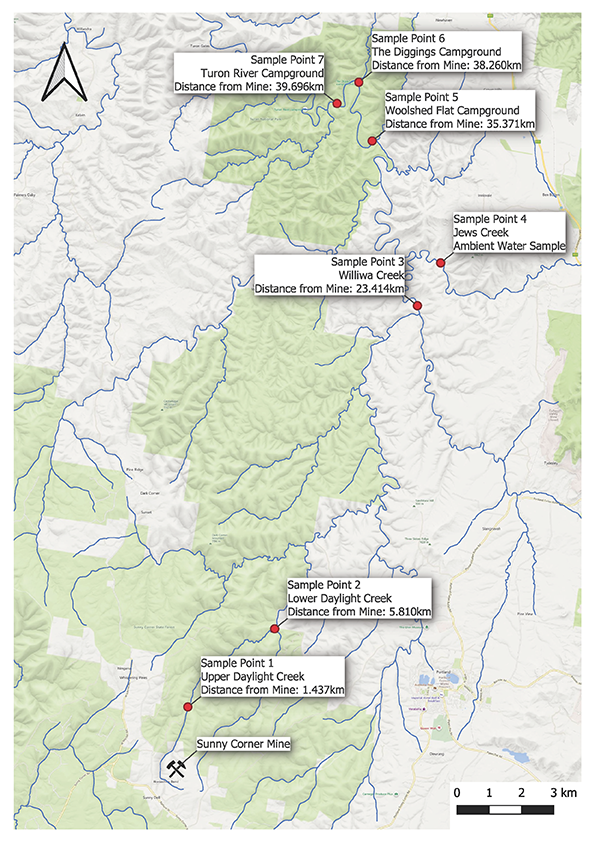Water sampling – Turon River near Sunny Corner
Sunny Corner is an historic silver, lead and zinc mining site located between Lithgow and Bathurst, 180 km west of Sydney, NSW.
Mining commenced at Sunny Corner in 1875 and continued until 1949. During mining and post closure acid mine drainage has discharged into Daylight Creek. The Department of Regional NSW has invested $ 1.2 million on remediation work at Sunny Corner which has included earthworks to reduce the generation of acid mine discharge from the historical mining site.
Following some concerns raised by members of the community, the EPA has commenced a seasonal water sampling and testing program for waterways downstream of the legacy Sunny Corner mine. The purpose of the sampling program is to confirm that the legacy Sunny Corner mine is not likely to have an impact on the health of recreational users of the downstream waterways.
Sample locations
Water samples have been collected from three monitoring rounds to date (spring 2023 and autumn and winter 2024) from the following sites downstream of the former mine:
- Sample point 1 – Daylight Creek, 1.4 kilometres downstream of the former mine (in-field probe measurements only during Spring 2023 monitoring).
- Sample point 2 – Daylight Creek, 5.8 kilometres downstream of the former mine.
- Sample point 3 – Williwa Creek, 23 kilometres downstream of the former mine.
- Sample point 4 – Jews Creek, upstream of Williwa Creek and not downstream of the former mine.
- Sample point 5 – Woolshed Flat Campground, Turon River, 35.7 kilometres downstream of the former mine.
- Sample point 6 – The Diggings Campground, Turon River, 38.3 kilometres downstream of the former mine.
- Sample point 7 – Turon River Campground, Turon River, 39.7 kilometres downstream of the former mine.
Results summary
Recreational Water Quality
There were no exceedances of the Recreational Water Quality Guidelines with the exception of samples collected from the 2 sites closest to the legacy Sunny Corner mine. This indicates that the concentrations of these chemicals do not pose risks to swimmers or other recreational users at the camping grounds noted in the figure above. Table 1: Recreational Water Guideline values, summarises the sample results vs recreational water quality guidelines from the 3 rounds of monitoring undertaken to date.
Samples from sites 3 to 7, including the Turon River sites, generally indicated relatively good water quality, with neutral pH, low turbidity, and low concentrations of metals with the exception of zinc. Aluminium, lead, nickel and zinc were elevated at Sites 1 and 2 but were substantially lower at the Turon River sites indicating that concentrations were decreasing downstream of the former mine. The electrical conductivity of the samples from sites 3 to 7 was higher than the guideline value, but this is not unusual for waterways in the region and the Williwa Creek sample was slightly acidic. The Jews Creek sample also had higher electrical conductivity than the sites downstream of the former mine.
Ecological Water Quality
Dissolved metals are used for ecological assessments as this is the fraction of the metal (the part that is toxic to organisms) as provided in Table 2: Water Quality Guideline Values for upland river aquatic ecosystems.
Several metals (Zinc, lead, copper, cobalt and cadmium) were above aquatic ecosystem health guideline values at Sites 1 and 2 on Daylight Creek, the closest sites to the former Sunny Corner mine, which indicates a risk to aquatic animals and plants. The elevated metals concentrations in Daylight Creek samples are consistent with, although lower than, sampling results reported in published literature (eg Hayes et al. 2003).
Next steps
The EPA will continue to undertake seasonal water quality monitoring at recreational locations downstream of the Sunny Corner mine with additional rounds proposed for spring 2024 and summer 2024/25. This summary report will be updated as results come in.
References
ANZG (2018). Australian and New Zealand Guidelines for Fresh and Marine Water Quality: Default Guideline Values, http://www.waterquality.gov.au/anz-guideline-values/default.
Australian Drinking Water Guidelines (2011), https://www.nhmrc.gov.au/about-us/publications/australian-drinking-water-guidelines#block-views-block-file-attachments-content-block-1.
Hayes, W. J., Chaudry T. M., Buckney, R.T., and Khan, A.G. (2003). Phytoaccumulation of Trace Metals at the Sunny Corner Mine, New South Wales, with Suggestions for a Possible Remediation Strategy. Australasian Journal of Ecotoxicology Vol. 9. PP. 69-82.
National Health and Medical Research Council (2008). Guidelines for Managing Risks in Recreational Water.https://www.nhmrc.gov.au/about-us/publications/guidelines-managing-risks-recreational-water#block-views-block-file-attachments-content-block-1
